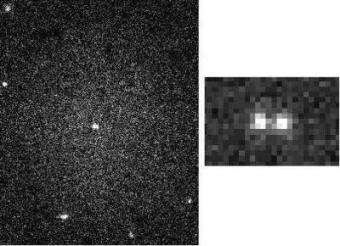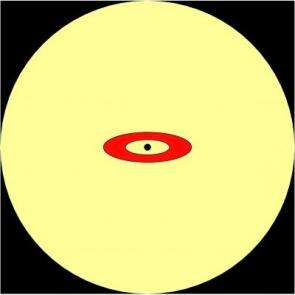Astronomers detect black hole in tiny 'dwarf' galaxy

Astronomers have found evidence of a supermassive black hole at the heart of a dwarf elliptical galaxy about 54 million light years away from the Milky Way galaxy where Earth resides.
It is only the second time a supermassive black hole has been discerned in a dwarf galaxy, and only the third time that astronomers have observed a double nucleus at the heart of a galaxy, said Victor P. Debattista, a postdoctoral researcher in astronomy at the University of Washington.
The galaxy, called VCC128, lies in the Virgo Cluster and is about 1 percent the size of the Milky Way. All of its stars combined would equal 100 million to 1 billion of our suns, Debattista said.

"It's a very small galaxy, on the outskirts of the cluster," he said. "It is effectively the smallest galaxy in which there is a supermassive black hole."
Black holes lie at the center of many galaxies, and have gravitational fields so powerful that nothing – not even light – can escape. A supermassive black hole is so large that its mass equals anywhere between 100,000 and 10 billion of our suns.
Debattista is the lead author of a poster detailing the discovery being presented today at the American Astronomical Society national meeting in Seattle. Co-authors are Ignacio Ferreras of Kings College in London, Anna Pasquali of the Max-Planck-Institut für Astronomie in Germany, Anil Seth at the Harvard-Smithsonian Center for Astrophysics in Boston, Sven De Rijcke of the Universiteit Gent in Belgium, and Lorenzo Morelli of Pontificia Universidad Católica in Chile.
The scientists were sifting through archived data from the Hubble Space Telescope when they found the supermassive black hole. They were studying the nuclei of dwarf galaxies, which are thought to develop from globular clusters, tightly packed spherical collections of stars that orbit a galaxy. As they examined the properties of the nuclei, they discovered one galaxy, VCC128, that had a double nucleus. Ultimately they determined the double nucleus is made up of two points of light from stars collected at opposite edges of a ring surrounding a black hole. Using the 3.5-meter telescope at the Apache Point Observatory in New Mexico, they measured properties of light from the nucleus and found that the nucleus is a ring of stars at least 1 billion years old, meaning the system probably is very stable.
"The fact that we found a black hole is impressive because it's been thought that a galaxy this small should not be able to host a black hole," Debattista said. "It had been speculated that dwarf galaxies like this could not make black holes."
The researchers believe the black hole has a mass at least equal to the ring of stars surrounding it, ranging from 1 million to 50 million times the mass of our sun.
"The question remains whether other dwarf galaxies with bright nuclei are indeed similar systems. We may not see more of these stellar rings because they are so small," said Ferreras.
The finding helps in understanding the processes occurring in low-mass dwarf galaxies as they travel through space and merge with other dwarfs to form larger galaxies. As that happens, their black holes also become more massive.
"The dwarf galaxies that escaped from this merging process offer us the opportunity to study the properties of the building blocks of today's massive galaxies and the supermassive black holes they host," said De Rijcke.
Source: University of Washington





















